And Who Hasn’t Enjoyed the Cool, Zesty Taste of Mint? –
The Tule Lake Basin is one of two places in California where peppermint
is grown. Tulelake Peppermint is well known for its consistent flavor and excellent
quality. Warm days, cool nights, rich volcanic soil and talented farmers all factor
into the production quality. Three M Mint grows and distills peppermint to oil
at their operation in Tulelake, California. One 400-pound drum of mint oil can produce
400,000 tubes of toothpaste, 5 million sticks of gum, and 20 million mint candies.
The goal of this video was to introduce buyers to the region, and specifically, to growing
and distilling mint in the Tule Lake Basin. Most of the visuals were filmed in 2002 and 2003.
This video was produced in 2004 by Three M Mint. Imagery and editing by Anders Tomlinson.
Written by Rob Crawford, narration by Brian Moore, student photos by Matt Hartung.
Music by SonicAtomics.
♦ A Year In the Life Of Tulelake Mint
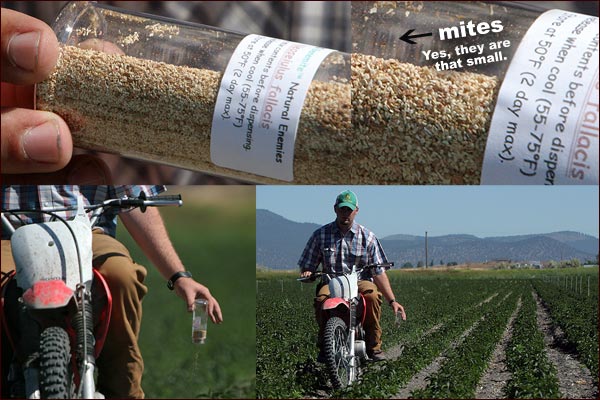
Using Mites to Control Mites –
This vial contains 5,000 tiny predator mites that will attack spider mites that are troublesome
to mint plants. Most of the material seen here is food and habitat for the miniscule mites.
Application of these natural predators for pest control is an experimental process.
Here, Bryce Crawford, at the time a sophomore at Oregon State, combines his love
of bikes with farming on the first day of July.

It Takes A Village To Raise This Mint –
The tule Lake Basin is tightly regulated in regards to pesticide use. One reason is
that farming does take place on private and National Wildlife Refuge lands.
These lands share water and work together as one system. Weeding crews will move
through the fields eradicating errant weeds by hand. These are friends, and in many
cases family, and much of their lives are shared in the fields. And it is a paycheck.

It Takes Sun, Water, Soil and Farmers to Grow Crops –
Peppermint comes from the name of a nymph in Greek and Roman mythology,
Mintha who was changed into a plant. Peppermint, first identified in 1696, is a natural
hybrid resulting from crossing from spearmint with wintermint. Since ancient times
spearmint has been used medically.

Farmland and Wildlife Refuge Can Be One –
The Tulelake Basin has long, warm days and cool nights that protects the mint oil having a
bitter taste. It is obvious these friendly insects enjoy the taste of Tulelake peppermint leaves.

It Is Harvest Time in a Tulelake Mint Field –
The normal date for harvesting mint in the Tulelake basin is August first. If it is a
cool summer the harvest can be two or more weeks later. Patience is needed.
In these photos it is 3:30 in the afternoon on August 2. Let the mint harvest begin.
A swather, used with other row crops, cuts a “swath” through the mint.
Fresh-cut sweet-pungent-mint fragrance fills the air. Mint leaves, are left to dry
on the ground. In a couple of days they will be raked into windrows.

On-board With A Tractor Driver, Captain of the High Fields –
Peppermint has been raised in Northern California for a couple of decades.
The University of California has been researching peppermint for 50 years.
Now is the time it all falls into the hands of tractor and truck drivers.

After Three Days of Drying on the Ground –
This sequence of photos begins at 7:32 a.m. on August 5th. Mint leaves are gathered,
chopped into small bits using a forage harvester and blown into tubs-trailers.
By 7:48 they are being trucked to the still.

The Mint Arrives at the Production Facility –
Trucks arrive at the still and connect to the system. Steam is injected into the tubs. Hot steam evaporates oil in the leaves. Pressure returns steam with oil to the still. Condensers turn the steam into liquid water and oil. Cans with interior baffles separate oil from water.
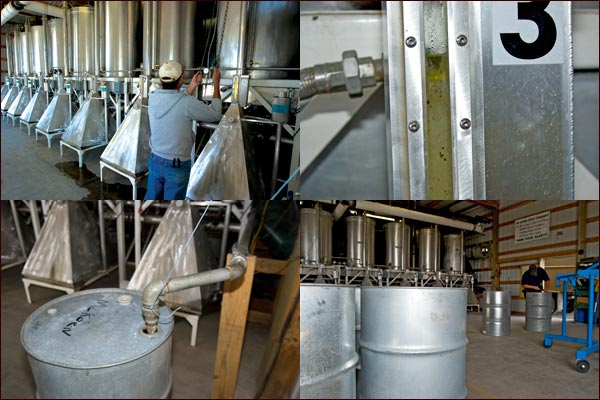
Mint Oil is Being Prepared for a Waiting Market –
This oil can be used in toothpaste, candy, gum, pharmaceuticals, mouthwash and cosmetics.

From Seed to Plant to Still and Back to the Land –
Mint slugs, the dried out plant material still in the tubs that took them from the
field to the processing still, are driven back to selected fields. The slugs are still
hot and will smolder for a couple of days. The slugs are used as compost-ground cover
and cows and deer are known to munch on the mint leaves when they have cooled down.

The Best Laid Plans of Man Can Have Unexpected situations –
Farming is a business with expenses and scheduling which have a direct impact
on each other. The unexpected effects both expenses and scheduling. Here is an
example of what can, and does, happen. August 6th, 2005, 8:30 am – a tub was being
raised up to empty 7 tons of cooked mint slugs onto a field.
To see more about What happens to the errant mint tub?
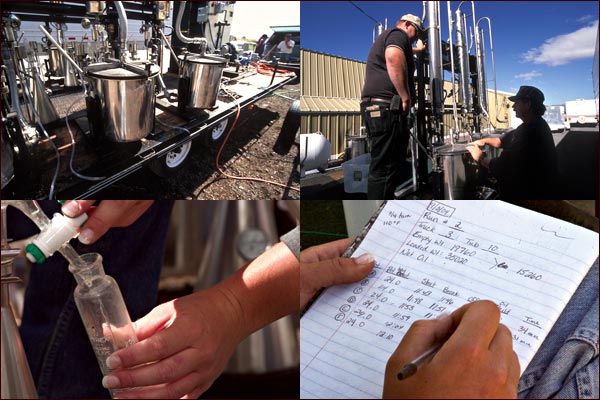
U.C. Intermountain Research and Extension Service’s Mini Still –
The small peppermint still is used for studying production and evaluating the quality of oil. Intermountain Research and Extension Service has five acres of mint planted for research:
irrigation, fertilization, nutritional, distilling, insect and harvest management.

Would You Like A Cup of Tea? –
Mint tea leaves, another mint crop is raised in the Tulelake Basin, are loaded into
semi-trucks headed for Madras, Oregon to be cleaned and sorted into steeping leaves
or tea bags. Steeping leaves will be made into 44 pound bricks and exported.

Soon the Sun Will Set and A Harvest Day Ends –
Harvest is a coordinated mechanic ballet requiring two drivers be as one.
Here, the combine, specially adapted, is moving through the mint field picking up and
shaking the leaf loose from the stem. The leaves are then “hopped” large container on the
back of a tandem axel truck. The vulnerable cut mint had been drying on the ground in windrows
and were rained on twice by surprise storms which could adversely
affect, their appearance.
The Seus Family Farm’s mint tea leaves harvest would close later in the evening.

Mint Root Stalk Being Planted in a New Field –
In the fall Tulelake farmers plant certified verticillium wilt-free rootstock.
It is common for the root stalk to produce crops for five or more years.
40 to 90 pounds of mint oil per acre are usually produced the first year
with 60 to 120 pounds of mint oil in the next years.
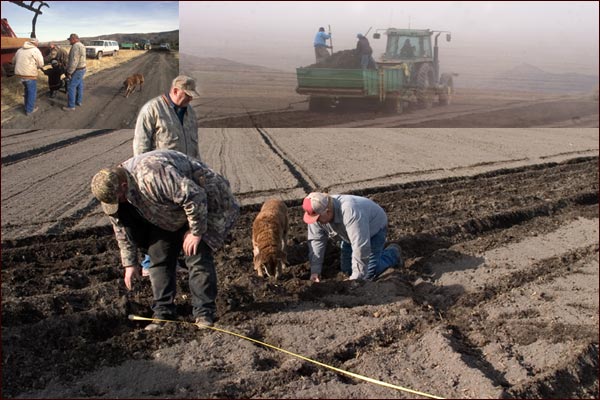
Crop Consultants Come in All Colors and Sizes –
It is late in the afternoon of November 14th. Carolyn, a Chesapeake Bay Retriever, is an
11 year old basin native. This is her sixth season as a Mitcham peppermint crop consultant.
Attentive local farmers, always in search of improving their yield and quality, focus on
Carolyn’s every bark and gesture. Seriously, John Crawford, Lee and Mike Mckoen are checking
to see if they have the proper depth and spacing for the rootstock being planted.
The harvest across the basin usually ending with onions, is wrapping up and fields are being
prepared for the next year. In the photo on the upper left the tractor will soon disappear
into a ground hugging persistent fog. No one said farming is easy.
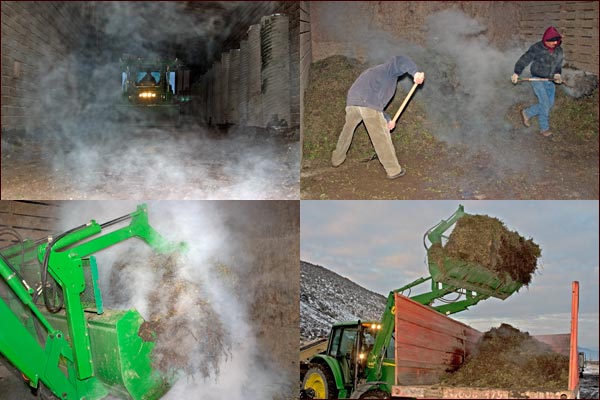
With Farming There Are Days Filled With Surprises –
Mint root stalk, stored in a potato cellar, began to combust from its own heat. The farmers
quickly needed to react to this event. They also were aware of the photographic opportunities
and called to see if I could document the situation. The mint root stalk needed to be moved.

And The Mint Planting Must Go On –
The farm crew came together and the warm mint root stalk met the cool Tulelake ground.
Farming is mainly planning with several moments of pure reacting to unseen events.
Working with nature means anything can happen. In this case a field was
planted earlier than planned.

Winter Has Settled Into the Tulelake Basin –
The cold will not harm the hardy mint. In fact, the cold can help reduce potential diseases.

Next Year, Early May In A Mint Field –
A mint plant stands as an island unto itself. Many of the fields have standing water on
their surface from a spring downpour. The mint needs the field to dry out. The farmer wants
warm sun and no more rain for several days. Farmers plan for the expected and prepare for
the unexpected. A new year and a new mint crop will be a coming.
![]()
Tulelake Potatoes
Tule Lake Basin potatoes are famous around the world. An acquaintance of Anders emailed, in the late 2000’s, that a Chilean potato shed office computer’s screen-saver displayed a anderstomlinson.com/tule-lake/ Tulelake potato harvest image. It is indeed a small world and potatoes have become an integral part of the global food supply. It is the world’s fourth-largest food crop, following maize, wheat and rice.
![]()
Tulelake Grain
Grain is cut by the header and kernels are separated and up to 5 tons stored in the combine. Chaff is sent flying out the back. These harvest photos are from the 2005. On average a grain crop may take four months from planting to harvest.
Tulelake wheat and barley have the best yield per acre in the western United States.
![]()
Tulelake Mint
The Tule Lake Basin is one of two places in California where peppermint is grown. Tulelake Peppermint is well known for its consistent flavor and excellent quality. Warm days, cool nights, rich volcanic soil and talented farmers all factor into the production quality.
![]()
Tulelake Alfalfa
Tule Lake Basin alfalfa is known for its excellent nutritional value. There are over 60,000 acres of hay, alfalfa and grass varieties, in the Upper Klamath Basin. Haying, on average, takes place from June 1 through Oct. 15. Of course, harvest timing is is related to weather conditions throughout the season.
![]()
Tulelake Onions
The last crop to be harvested in the Tule Lake Basin is usually onions. As late as mid-November trucks with Tulelake onions can be a daily parade down Hwy. 97 to Hwy. 5 south. Drivers take their trailers to Sacramento. There, drivers coming from Gilroy trade trailers and take the onions south for processing.
![]()
Tulelake Horseradish
Tulelake is known as the “Horseradish Capital of the World” and accounts for a third or more of the nation’s production. Some local fields have been in continuous horseradish production for 25 years. Horseradish has been cultivated for at least 3,000 years.
Special thanks to Crawford Farms, Three M Mint and the McKoens.
©2014 Anders Tomlinson, all rights reserved.









